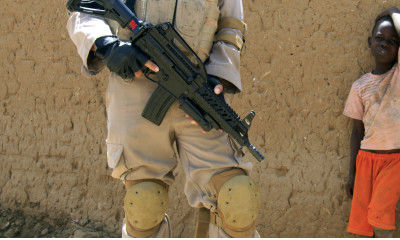 By Eric Reeves
By Eric Reeves
This article first appeared on The Huffington Post: http://www.huffingtonpost.com/eric-reeves/on-invoking-the-deaths-of_b_3968044.html
September 21, 2013 (SSNA) — One of the most dismaying features of current discussions about how the U.S. should respond to Syria’s use of chemical weapons against civilians, including hundreds of children, is the moral framework that has been created, ultimately in service of political goals. The implicit claim has been made repeatedly, including by U.S. Secretary of State John Kerry, that some children’s deaths are more “obscene” or “heinous” than others. I believe this to be a dismayingly invidious comparison. The claim that a child who dies from a chemical attack dies a more horrible death than the child in Darfur who dies in agony, over many hours, having been eviscerated by the shrapnel exploding out a bomb dropped from a high-flying, grossly inaccurate cargo plane known simply as the “Antonov.”
Antonovs have been a critical part of the military arsenal of Khartoum’s National Islamic Front/National Congress Party regime, and its Sudan Armed Forces (SAF), for many years. They have deliberately — with regularity and unconstrained brutality — attacked civilian targets, and even humanitarian operations, including those of the International Committee of the Red Cross and the UN’s World Food Program. Such an utterly indiscriminate bombing campaign has no direct military purpose; it is, however, a highly effective weapon if the goal is to destroy populations and the agricultural capacity perceived as supporting various rebel groups, a number of which have emerged throughout Sudan’s cruelly marginalized peripheral areas.
This is currently the case in Darfur, in Blue Nile and in South Kordofan states — all on the western or southern periphery of what is now (northern) Sudan. South Sudan endured the brunt of Khartoum’s aerial assaults during the long civil war, going back to the 1990s; substantial data began to be collected in 1999 following the many deliberate bombings of hospitals by Khartoum in what was then Equatoria. The South — in the increasingly likely event of resumed all-out war between Khartoum and Juba over the contested area of Abyei — will again become the target of indiscriminate aerial bombardment. The specific purposes for Khartoum’s recent acquisition of a dozen Sukhoi Su-24 precision attack aircraft may soon be clear. But the lumbering, deadly Antonovs — crudely retrofitted Russian cargo planes which have no bomb-sighting mechanism — will do most of the work in a war that will again focus on civilian destruction, not military victory.
Moreover, since no avionic equipment in the world can make of the Antonov anything more than an indiscriminate instrument of civilian destruction — given their 5,000-meter cruising and attack altitude — we confront again the question of invidious comparisons implicit in statements by Kerry and others. Why is the death of a Syrian ten-year-old boy from Sarin gas any more significant, morally or otherwise, than the agonizing death of the eviscerated seven-year-old girl in Darfur, whose robust constitution allows her to fight off death for hours, all of which are passed in a state of tremendous pain from which there is no medical or even analgesic relief.
And if there is no medical relief, it is in all probability because Khartoum so widely obstructs humanitarian efforts in Darfur, as well as movements of the feckless UN/African Union peacekeeping mission (UNAMID). For more than three years, the eastern Jebel Marra area in the center of the Darfur region has been under humanitarian embargo — of precisely the sort Khartoum has previously imposed on relief organizations in South Sudan, in eastern Sudan, in the Nuba Mountains of South Kordofan during the 1990s, and now most conspicuously in Blue Nile State and, again, the Nuba Mountains.
More than a million people, perhaps many more, are at acute risk in South Kordofan and Blue Nile — largely because Khartoum’s Antonovs have destroyed fields and wells and markets on which the broader agricultural economy was based. People are starving, and may soon starve in great numbers, given the failure of this year’s planting season. The Antonov may be crude, but it is a highly effective weapon of mass destruction — true mass destruction, measured not in the thousands but the many hundreds of thousands. Antonov attacks take place on a virtually daily basis according to multiple Darfuri reports from the ground in Darfur; similar reports come from the Nuba Mountains and Blue Nile.
Destruction of wells and villages, the loss of livestock and an unrelenting death and despair — these are the “bombs” the Antonovs drop. And sometimes the children, invisible to us because we choose not to look, or even compel UN observation, are terribly wounded by these bombs. To suggest that their terrors, their pain and agony, their deaths are any less “morally obscene” than gas attacks on children in Syria is a painfully invidious comparison — the more so since in the end, it is politically expedient.
A substantial update to my lengthy report and data archiving (“‘They Bombed Everything that Moved’: Aerial Military Attacks on Civilians and Humanitarians in Sudan, 1999 – 2013″), www.sudanbombing.org) will be posted on that site September 22, 2013; it focuses on events in Darfur, June 2012 – September 2013.
Eric Reeves is a professor at Smith College and has written extensively on Sudan.

